Pasta Recipes
How to Make Delicious Gluten Free Pasta at home

Eating gluten free doesn’t mean you have to give up the simple pleasure of pasta. Whether you’re following a gluten free diet for health reasons or personal choice, creating a gluten free pasta recipe at home is easier than ever. With the right ingredients and techniques, you can craft pasta that’s just as delicious, satisfying, and versatile as traditional wheat-based pasta. Let’s explore how you can make your own gluten free pasta right in your kitchen.
What You Need for Gluten Free Pasta
Before we get into the process, let’s make sure you have the necessary ingredients to create a successful batch of gluten free pasta. Here’s what you’ll need:
- Gluten Free Flour Blend: A combination of rice flour, tapioca starch, and potato starch works well.
- Xanthan Gum or Guar Gum: This acts as a binding agent, replacing the gluten.
- Eggs: Large eggs provide richness and structure.
- Olive Oil: Adds moisture and a subtle flavor.
- Salt: Essential for flavor balance.
- Water: For adjusting the dough’s consistency.
Why Use a Gluten Free Flour Blend?
The key to great gluten free pasta is selecting the right flour blend. A balance between different starches and flours helps mimic the elasticity and texture of traditional wheat flour. Rice flour provides a mild flavor, while potato starch and tapioca starch bring the chewiness and lightness needed for a satisfying pasta.
Step-by-Step Gluten Free Pasta Recipe
1. Mixing the Dough
Start by combining 2 cups of gluten free flour blend with 1 teaspoon of xanthan gum in a large mixing bowl. Make a well in the center and crack in 3 large eggs. Add 1 tablespoon of olive oil and a pinch of salt. Using a fork, gently beat the eggs, gradually incorporating the flour into the mixture. Add a tablespoon of water at a time if the dough feels too dry.
Once the dough begins to come together, transfer it to a floured surface and knead it for about 5-7 minutes. This step helps the ingredients to fully combine and gives the dough a smooth texture. The dough should be firm but not crumbly. If it cracks, add a bit more water.
2. Resting the Dough
Cover the dough with plastic wrap and let it rest for 20-30 minutes. Resting allows the xanthan gum to activate, giving the dough better flexibility and making it easier to roll out.
3. Rolling and Cutting the Pasta
Divide the dough into smaller portions. Using a rolling pin or a pasta machine, roll each portion to your desired thickness. Gluten free pasta dough tends to be slightly more fragile than traditional dough, so roll carefully to avoid tearing. Dust the dough with extra gluten free flour if needed to prevent sticking.
Once the dough is rolled out, cut it into your preferred pasta shape. You can make fettuccine, tagliatelle, or even use the dough to create gluten free ravioli.
4. Cooking the Pasta
Boil a large pot of salted water. Gently drop in your freshly cut pasta and cook for 3-4 minutes. Gluten free pasta cooks much faster than wheat-based pasta, so keep an eye on it to avoid overcooking. The pasta should be al dente, offering a firm bite but still tender.
Once cooked, drain the pasta and toss it in your favorite sauce, or simply drizzle with olive oil and sprinkle with parmesan cheese for a simple, satisfying meal.

Tips for Perfect Gluten Free Pasta Every Time
1. Use a Flour Blend Designed for Pasta
Not all gluten free flours are created equal. When making pasta, it’s important to use a flour blend that’s specifically designed for pasta making. You’ll often find that all-purpose gluten free blends work fine, but certain brands may offer pasta-specific blends that result in a better texture.
2. Don’t Skip the Xanthan Gum
This ingredient is crucial for giving your pasta dough elasticity and chew. If you leave it out, you may find that the dough is brittle and falls apart during rolling or cooking.
3. Knead with Patience
Gluten free doughs don’t require as much kneading as traditional doughs, but they still benefit from some hands-on time. Kneading ensures that the xanthan gum is evenly distributed and that your dough has the right texture.
4. Cook in Abundant Salted Water
Salted water not only flavors the pasta but also helps prevent the pasta from sticking together. Be sure to use plenty of water and stir the pasta occasionally as it cooks.
Gluten Free Pasta Variations
One of the best things about making your own pasta is the ability to customize it. Here are a few fun variations to try:
1. Spinach Gluten Free Pasta
Add a handful of cooked, pureed spinach to your dough for a vibrant green color and an added dose of nutrients. Be sure to squeeze out any excess moisture from the spinach before adding it to the dough.
2. Beetroot Gluten Free Pasta
For a stunning magenta color, mix in some pureed, roasted beetroot. This version pairs beautifully with goat cheese and walnuts for an earthy, slightly sweet dish.
3. Vegan Gluten Free Pasta
To make your pasta vegan-friendly, simply replace the eggs with a combination of flaxseed meal and water (1 tablespoon flaxseed meal + 3 tablespoons water for each egg). This substitution works particularly well when combined with a high-protein flour blend.
The Best Sauces for Gluten Free Pasta
Pairing your homemade pasta with the right sauce can elevate the dish to a whole new level. Here are a few gluten-free sauce ideas:
1. Classic Marinara
A rich tomato-based sauce is a timeless option. Sauté garlic in olive oil, add crushed tomatoes, basil, and a pinch of salt for a sauce that complements any pasta shape.
2. Creamy Alfredo
For a decadent, cheesy sauce, melt butter in a saucepan and stir in heavy cream. Add freshly grated parmesan and stir until smooth. Season with salt and pepper, and serve over fettuccine.
3. Pesto
For a fresh, herbaceous option, blend fresh basil, garlic, pine nuts, and parmesan with olive oil. This sauce is perfect for gluten free penne or spaghetti.
4. Garlic and Olive Oil
For a lighter option, sauté garlic in olive oil, add a dash of red pepper flakes, and toss your pasta to coat. Sprinkle with parsley for a simple but flavorful dish.
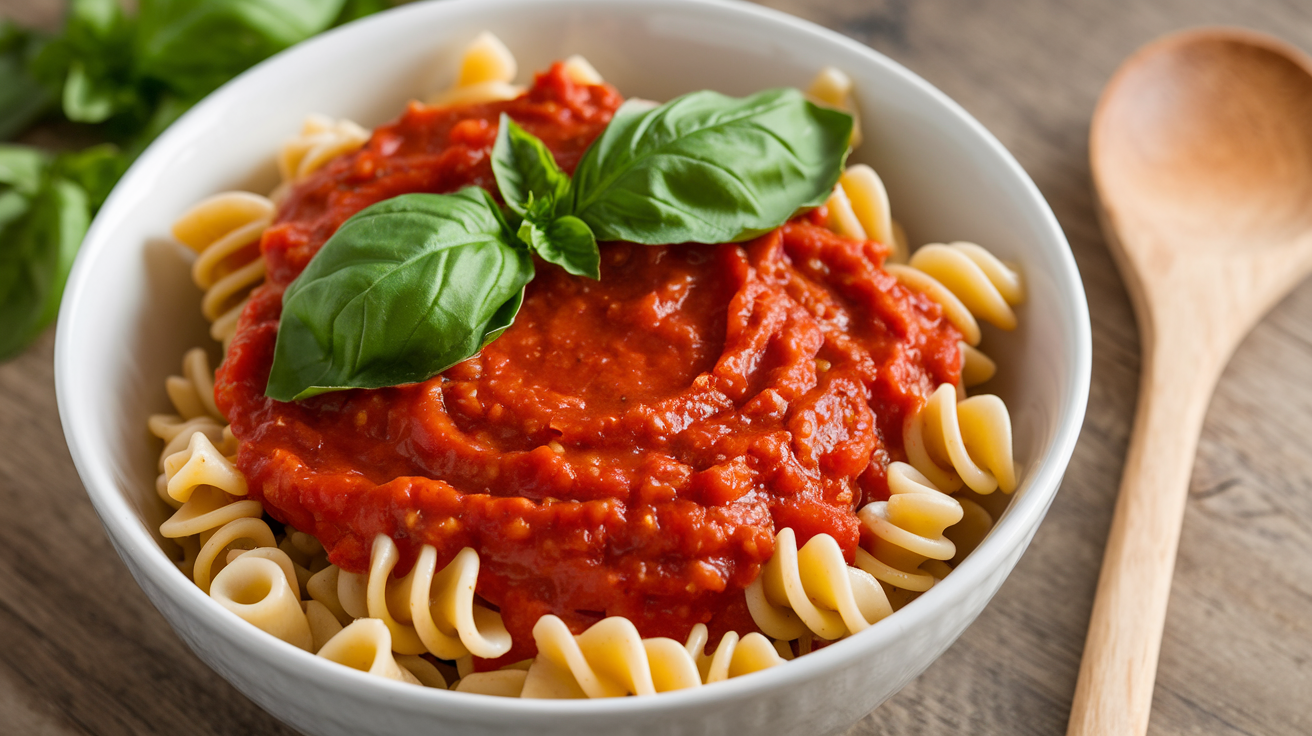
Faq’s
1. What is gluten-free pasta made of?
Gluten free pasta is typically made from a variety of alternative flours such as rice flour, corn flour, quinoa flour, or a blend of starches like tapioca and potato. It may also contain binding agents like xanthan gum to help mimic the texture of traditional wheat pasta.
2. How do I prevent gluten-free pasta from falling apart?
To prevent gluten free pasta from falling apart, it’s important to add a binding agent like xanthan gum or guar gum to the dough. Additionally, kneading the dough well and allowing it to rest before rolling helps improve its elasticity and texture.
3. Can I make gluten-free pasta without eggs?
Yes, you can make gluten free pasta without eggs by using substitutes such as flaxseed meal mixed with water or aquafaba (chickpea water). These alternatives help bind the dough together and work well in vegan pasta recipes.
4. How long does gluten-free pasta take to cook?
Gluten free pasta generally cooks faster than traditional wheat pasta. Fresh gluten free pasta usually takes around 3-4 minutes to become al dente, while dried gluten free pasta takes 7-10 minutes depending on the brand.
5. Why is my gluten-free pasta dough too dry or too sticky?
If the dough is too dry, add small amounts of water until it becomes more pliable. If it’s too sticky, add a bit more gluten free flour blend. The consistency of gluten free dough can vary based on the type of flour blend you’re using, so it’s important to adjust as needed.
6. Can I store gluten-free pasta dough for later use?
Yes, you can store gluten free pasta dough. Wrap it tightly in plastic wrap and refrigerate it for up to 24 hours. For longer storage, you can freeze the dough for up to 3 months. Just let it thaw before rolling and cutting.
7. What sauces pair best with gluten-free pasta?
Gluten free pasta pairs well with most traditional sauces, including marinara, Alfredo, pesto, and garlic and olive oil. Just ensure that any sauce you choose is also gluten free, as some store-bought sauces may contain gluten.
8. Is gluten-free pasta healthier than regular pasta?
Gluten free pasta is not necessarily healthier than regular pasta. It’s a good option for those with gluten sensitivities or celiac disease, but its nutritional value depends on the ingredients used. Some gluten free pasta options are enriched with more nutrients, while others may be lower in fiber and protein.
9. Can I make stuffed gluten-free pasta like ravioli?
Yes, you can make gluten free stuffed pasta like ravioli. The key is to roll the dough thin enough to fold and seal properly without tearing. A gluten free flour blend with xanthan gum works best for achieving the necessary flexibility for stuffed pasta.
10. How can I make gluten-free pasta more flavorful?
To enhance the flavor of gluten free pasta, you can incorporate herbs like basil, parsley, or oregano directly into the dough. Using vegetable purees like spinach or beetroot is another way to add color and subtle flavors. Additionally, cooking the pasta in salted water helps boost its taste.
Conclusion
Making gluten free pasta at home is not only possible but also incredibly rewarding. With the right flour blend and technique, you can enjoy pasta that rivals any store-bought gluten free option. Whether you’re a fan of traditional shapes or want to experiment with colorful variations, the flexibility of homemade gluten free pasta is unmatched.
Please visit our website for more delicious recipes: FoodiesDen
Pasta Recipes
test
test
Pasta Recipes
Creamy Mushroom Pasta Recipes That Are Irresistible
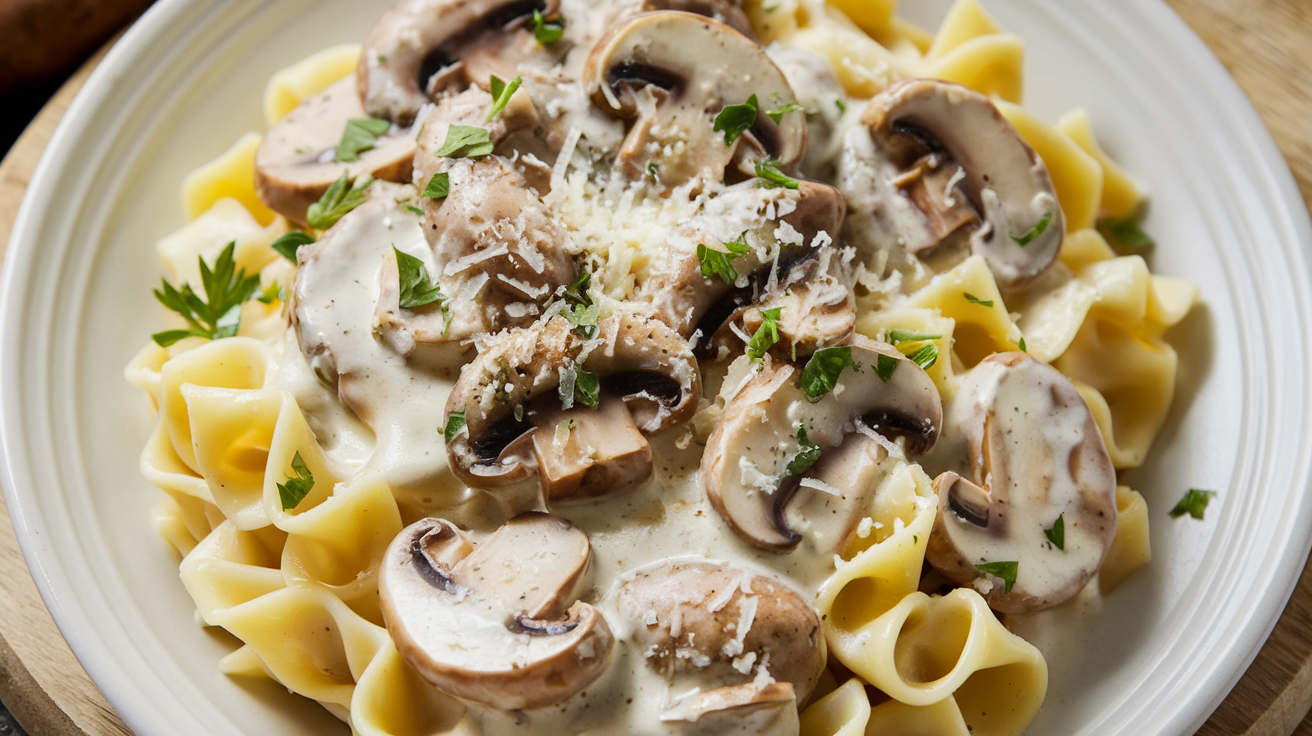
Creamy Mushroom Pasta Recipes That Are Irresistible
Creamy mushroom pasta is a comforting dish that combines rich, earthy flavors with the silkiness of a cream-based sauce. Whether you’re a seasoned cook or just beginning your culinary journey, creamy mushroom pasta is an easy yet indulgent dish that brings a touch of gourmet dining to your home. This article will introduce you to some delicious creamy mushroom pasta recipes that are irresistible, versatile, and perfect for any occasion. So, grab your ingredients and prepare to make a meal that everyone will love!
The Allure of Creamy Mushroom Pasta
Mushrooms are not only packed with nutrients, but they also offer a unique, savory flavor that elevates a dish. When combined with a creamy sauce, the umami notes from the mushrooms blend seamlessly with the richness of cream, butter, and cheese, creating an irresistible flavor profile. Creamy mushroom pasta is versatile and can be tailored to different tastes by adding ingredients like spinach, garlic, or Parmesan. It’s a satisfying dish, ideal for cozy nights in or entertaining guests.
Let’s dive into some delightful creamy mushroom pasta recipes that are sure to impress your family and friends.
Classic Creamy Mushroom Pasta
If you’re looking for a traditional take on creamy mushroom pasta, this classic recipe is the way to go. It’s simple, flavorful, and made with just a few key ingredients.
Ingredients:
- 300g pasta (penne, fettuccine, or spaghetti)
- 250g mushrooms (button, cremini, or a mix of your favorite)
- 2 tbsp olive oil
- 1 tbsp butter
- 2 cloves garlic, minced
- 200ml heavy cream
- 50g Parmesan cheese, grated
- Salt and pepper to taste
- Fresh parsley for garnish
Instructions:
- Cook the pasta in salted boiling water until al dente. Drain and set aside.
- In a large pan, heat olive oil and butter over medium heat. Add the minced garlic and sauté for a minute until fragrant.
- Add the sliced mushrooms to the pan and cook until they become soft and golden brown, about 5-7 minutes.
- Stir in the heavy cream, bring to a gentle simmer, and cook for 3-5 minutes until the sauce thickens.
- Add the Parmesan cheese and stir until melted and combined.
- Season with salt and pepper to taste.
- Toss the cooked pasta into the sauce, ensuring it is fully coated.
- Garnish with fresh parsley and serve hot.
This classic creamy mushroom pasta is incredibly comforting and easy to make. It’s the perfect dish when you’re craving something quick but luxurious.
Creamy Garlic Mushroom Pasta with Spinach
Adding spinach to creamy mushroom pasta not only adds a pop of color but also brings additional nutrients to the dish. The combination of garlic, spinach, and mushrooms creates a well-balanced and hearty meal.
Ingredients:
- 300g fettuccine
- 200g mushrooms, sliced
- 2 cups fresh spinach
- 3 cloves garlic, minced
- 2 tbsp olive oil
- 1 cup heavy cream
- 1/2 cup vegetable broth
- 50g Parmesan cheese, grated
- Salt and pepper to taste
Instructions:
- Cook the fettuccine according to package instructions, drain, and set aside.
- In a large pan, heat the olive oil over medium heat. Add the minced garlic and sauté until golden.
- Add the sliced mushrooms and cook until softened and browned, about 5 minutes.
- Stir in the spinach and cook until wilted.
- Pour in the vegetable broth and heavy cream, bringing the mixture to a simmer.
- Add the Parmesan cheese and stir until melted. Let the sauce thicken for about 2-3 minutes.
- Season with salt and pepper to taste.
- Combine the pasta with the creamy mushroom spinach sauce and toss until well-coated.
- Serve with a sprinkle of Parmesan and enjoy!
This garlic-infused creamy mushroom pasta recipe is perfect for a satisfying dinner, combining the creaminess of the sauce with the fresh taste of spinach.
Vegan Creamy Mushroom Pasta
For those who follow a plant-based diet, creamy mushroom pasta can still be enjoyed! This vegan version is made with dairy-free cream and packed with rich flavors. It’s the ultimate comfort food, without any animal products.
Ingredients:
- 300g pasta (your choice)
- 250g mushrooms (cremini or portobello)
- 2 tbsp olive oil
- 1 onion, finely chopped
- 2 cloves garlic, minced
- 1 cup coconut cream or cashew cream
- 1/4 cup nutritional yeast
- 1 tbsp lemon juice
- Salt and pepper to taste
- Fresh basil for garnish
Instructions:
- Cook the pasta as per package directions, drain, and set aside.
- In a large skillet, heat the olive oil over medium heat and sauté the chopped onions and garlic until soft and translucent.
- Add the mushrooms and cook until golden brown and tender.
- Stir in the coconut cream or cashew cream and bring the mixture to a simmer.
- Add the nutritional yeast, lemon juice, salt, and pepper to the sauce.
- Let the sauce thicken slightly, then toss the cooked pasta into the pan and mix well.
- Garnish with fresh basil and serve.
This vegan creamy mushroom pasta is indulgent and flavorful, proving that you don’t need dairy to create a rich, creamy sauce.
Creamy Mushroom Pasta with Truffle Oil
If you’re looking to elevate your creamy mushroom pasta, truffle oil is the secret ingredient. It adds a luxurious, earthy aroma and takes the dish to gourmet levels.
Ingredients:
- 300g tagliatelle
- 200g mixed mushrooms (shiitake, oyster, and button)
- 2 tbsp olive oil
- 1 shallot, minced
- 1/2 cup heavy cream
- 1 tbsp truffle oil
- 50g Parmesan cheese, grated
- Salt and pepper to taste
- Fresh thyme for garnish
Instructions:
- Cook the tagliatelle in salted water until al dente. Drain and set aside.
- In a large pan, heat the olive oil over medium heat and sauté the minced shallot until softened.
- Add the mixed mushrooms and cook for about 5-7 minutes until they become golden and tender.
- Stir in the heavy cream and allow the sauce to simmer and thicken.
- Remove the pan from the heat and drizzle in the truffle oil. Stir until combined.
- Toss the pasta in the sauce, ensuring each strand is coated.
- Top with Parmesan cheese and fresh thyme before serving.
This creamy mushroom pasta recipe with truffle oil is perfect for a special occasion or a date night at home. The truffle oil enhances the earthy flavor of the mushrooms and adds a touch of luxury to this simple dish.
Frequently Asked Questions
What mushrooms are best for creamy mushroom pasta?
The best mushrooms for creamy mushroom pasta are cremini, button, shiitake, and portobello. You can use a combination of these for added flavor and texture.
Can I make creamy mushroom pasta ahead of time?
Yes, you can make creamy mushroom pasta ahead of time. Prepare the sauce and pasta separately, and combine them just before serving. Reheat the sauce gently on the stove before mixing it with the pasta.
How do I store leftover creamy mushroom pasta?
Leftover creamy mushroom pasta can be stored in an airtight container in the refrigerator for up to three days. When reheating, add a splash of cream or milk to revive the sauce’s texture.
Is creamy mushroom pasta gluten-free?
The pasta itself determines whether the dish is gluten-free. Simply swap out regular pasta for gluten-free pasta, and the rest of the recipe can remain unchanged.
Can I make creamy mushroom pasta without cream?
Yes! You can substitute heavy cream with cashew cream, coconut milk, or even dairy-free alternatives like almond cream for a lighter version of the dish.
What can I serve with creamy mushroom pasta?
Creamy mushroom pasta pairs well with garlic bread, a fresh green salad, or roasted vegetables. These sides help balance out the richness of the pasta.
Conclusion
Creamy mushroom pasta is an incredibly versatile dish that can be adjusted to suit various dietary preferences and flavor profiles. Whether you prefer a classic recipe, a plant-based alternative, or want to add a gourmet touch with truffle oil, these recipes are guaranteed to be a hit. The rich, creamy sauce combined with the earthy flavor of mushrooms creates a pasta dish that is both comforting and indulgent.
For more exciting recipe ideas, visit Foodies Den!
Pasta Recipes
7 Fiery Spicy Pasta Dishes That Heat Seekers Will Love! 🌶️

7 Fiery Spicy Pasta Dishes That Heat Seekers Will Love! 🌶️
If you’re a lover of bold flavors and enjoy a good fiery kick in your meals, spicy pasta dishes should be at the top of your list! Combining the comforting textures of pasta with the punch of heat, these dishes deliver a perfect blend of satisfaction and excitement. Whether you’re craving a classic Italian arrabbiata or something with a fusion twist like spicy Thai noodles, these pasta dishes will make you break a sweat in the most delightful way.
Let’s dive into some of the most tantalizing spicy pasta dishes that are sure to ignite your taste buds!
Why Spicy Pasta Dishes Are a Must-Try
Spicy pasta dishes combine the best of both worlds – the warmth and comfort of pasta, paired with the invigorating heat of spices and peppers. Not only do these dishes offer dynamic flavors, but the spice can also bring several health benefits. Capsaicin, the active component in chili peppers, is known to boost metabolism and enhance digestion. Plus, for those who enjoy the endorphin rush from spicy foods, these pasta dishes offer an ideal experience.
But the beauty of spicy pasta is how adaptable it is. Depending on your spice tolerance, you can adjust the heat level by adding more (or less) chili flakes, hot sauces, or spicy sausages. So, whether you’re a daring heat-seeker or just want a bit of a kick, there’s a spicy pasta dish for everyone.
Arrabbiata – The Classic Italian Spicy Pasta Dish
When we talk about spicy pasta dishes, arrabbiata always comes to mind. Originating from the Lazio region of Italy, this dish is made with simple, yet bold ingredients: tomatoes, garlic, and red chili peppers. The name “arrabbiata” translates to “angry” in Italian, reflecting the fiery heat of the sauce.
Ingredients:
- Penne pasta
- Tomatoes (fresh or canned)
- Garlic cloves
- Red chili flakes
- Olive oil
- Fresh basil
The sauce for arrabbiata is quick to prepare, but it’s the red chili peppers that steal the show, adding layers of heat and flavor to the dish. For a more intense kick, opt for crushed red pepper flakes or even fresh hot peppers. Don’t forget to garnish it with a bit of freshly grated Parmesan cheese and basil to balance the heat.
Spicy Cajun Pasta – A Southern Delight
Next on the list of must-try spicy pasta dishes is the crowd-pleasing Cajun pasta. This Southern-inspired dish brings a rich, smoky heat, thanks to the flavorful blend of Cajun spices. It usually includes chicken or shrimp, but you can easily make it vegetarian by adding bell peppers and mushrooms.
Ingredients:
- Fettuccine pasta
- Chicken or shrimp (optional)
- Bell peppers
- Cajun seasoning (a mix of paprika, cayenne, garlic powder, and thyme)
- Cream or milk
The secret to the perfect Cajun pasta lies in its spice mix. Cajun seasoning combines heat with aromatic spices, which create a robust, bold flavor profile. The creamy sauce mellows out the spiciness, making this a balanced yet exciting meal for any heat lover.
Spaghetti Aglio e Olio with Chili
For something simple yet incredibly flavorful, spaghetti aglio e olio with chili is a fantastic choice. This Italian classic usually calls for just olive oil, garlic, and parsley, but to give it that heat-seeker’s twist, adding chili flakes or fresh red chilies is key.
Ingredients:
- Spaghetti
- Olive oil
- Garlic cloves
- Red chili flakes or fresh chilies
- Fresh parsley
- Parmesan cheese (optional)
This dish allows the spicy element to shine, especially if you use fresh chilies. The oil absorbs the heat from the garlic and chili, creating a light yet potent sauce that clings perfectly to the spaghetti. For an added layer of flavor, you can sprinkle a bit of lemon zest on top to cut through the spice.
Spicy Thai Peanut Pasta
If you’re looking to explore global flavors in your spicy pasta dishes, try a spicy Thai peanut pasta. This dish features the unique combination of creamy peanut sauce, lime juice, and red chili paste, offering a rich, spicy, and tangy experience.
Ingredients:
- Rice noodles or linguine
- Peanut butter
- Soy sauce
- Red chili paste
- Lime juice
- Crushed peanuts
- Fresh cilantro
Thai red chili paste brings a fiery element to the dish, which is balanced by the creamy richness of peanut butter. Garnished with cilantro and crushed peanuts, this pasta dish delivers a zesty, spicy, and umami-packed flavor punch that heat seekers will love.
Spicy Pesto Pasta – A Twist on a Classic
For those who love basil pesto but crave a little more excitement, spicy pesto pasta is the perfect way to turn up the heat on this classic dish. By adding jalapeños or red chili flakes to traditional pesto, you can give your pasta a bold and fiery edge.
Ingredients:
- Fusilli or penne pasta
- Basil leaves
- Pine nuts or walnuts
- Olive oil
- Garlic cloves
- Parmesan cheese
- Jalapeños or red chili flakes
The spicy element cuts through the creaminess of the pesto, making each bite refreshing yet spicy. Serve it with grilled chicken or shrimp for a heartier meal, or keep it vegetarian by adding roasted vegetables.
Linguine Fra Diavolo – Devilishly Spicy Seafood Pasta
The name “fra diavolo” means “brother devil,” which already suggests the fiery nature of this spicy pasta dish. Often made with seafood like shrimp or lobster, this dish includes tomatoes, garlic, white wine, and, of course, plenty of red pepper flakes.
Ingredients:
- Linguine pasta
- Shrimp or lobster
- Crushed tomatoes
- White wine
- Garlic cloves
- Red pepper flakes
- Fresh parsley
The red pepper flakes create a punchy sauce that pairs beautifully with the sweetness of the seafood. For an even more intense heat, some cooks add extra fresh chilies. This dish is perfect for heat seekers who love seafood with their spice.
Chipotle Mac and Cheese – A Spicy Comfort Classic
Mac and cheese gets a spicy makeover with the addition of chipotle peppers, creating a creamy yet fiery version of this comfort classic. The smoky heat of chipotle pairs beautifully with the richness of the cheese sauce, making it an ideal dish for anyone who loves both creamy and spicy flavors.
Ingredients:
- Elbow macaroni
- Cheddar cheese
- Cream or milk
- Chipotle peppers in adobo sauce
- Butter
- Garlic powder
The chipotle peppers bring a unique smokiness and a steady burn that intensifies as you eat. If you’re feeling adventurous, you can even top it with crispy jalapeños or hot sauce for an extra kick.
FAQs
What is the best pasta to use for spicy dishes?
The best pasta for spicy dishes often depends on the sauce. Penne or rigatoni is great for thicker sauces like arrabbiata, while spaghetti works well with lighter sauces like aglio e olio.
How can I make my pasta less spicy if it’s too hot?
If you’ve overdone the heat, balance the spice by adding dairy (cream, milk, or cheese), which neutralizes some of the capsaicin, the compound responsible for the heat in chili peppers.
Can I adjust the spiciness in these recipes?
Absolutely! You can always adjust the level of heat by adding more or less chili flakes, hot sauce, or fresh peppers to suit your tolerance.
What can I serve with spicy pasta dishes?
Spicy pasta pairs well with cooling side dishes like a fresh green salad, garlic bread, or even yogurt-based dips like tzatziki to help balance the heat.
Is spicy food healthy?
Spicy foods have health benefits! They can boost metabolism, improve digestion, and even release endorphins, which can enhance your mood.
What’s the best way to store leftovers of spicy pasta dishes?
Store leftovers in an airtight container in the fridge for up to 3 days. The flavors, including the spiciness, often intensify over time!
With these spicy pasta dishes, you can take your taste buds on a thrilling ride! Whether you prefer the bold heat of Cajun pasta or the classic punch of arrabbiata, there’s a dish here for every level of spice lover. Ready to spice up your pasta game? Check out even more fiery recipes and tips at Foodies Den.
-
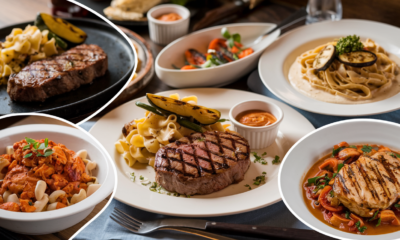
 Pasta Recipes10 months ago
Pasta Recipes10 months ago5 Delicious Steak and Pasta Recipes
-
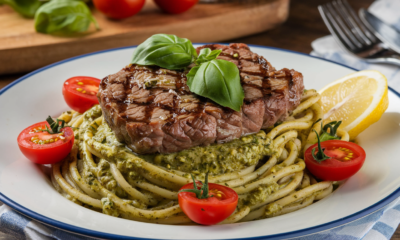
 Pasta Recipes10 months ago
Pasta Recipes10 months agoDelicious & Delightful Steak and Pesto Linguine Recipe
-
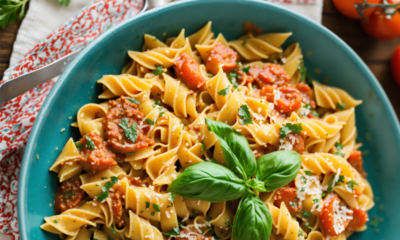
 Pasta Recipes9 months ago
Pasta Recipes9 months agoSwirly Pasta Recipe: Creative, Fun, and Delicious
-
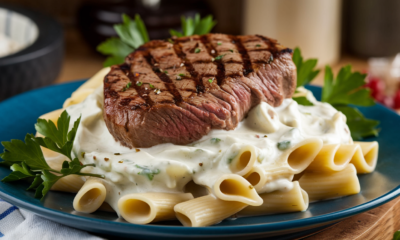
 Pasta Recipes10 months ago
Pasta Recipes10 months agoDelicious & Creamy Steak Alfredo Recipe
-

 Pasta Recipes9 months ago
Pasta Recipes9 months agoBrown Rice Pasta Recipe: A Healthy, Gluten-Free Alternative
-
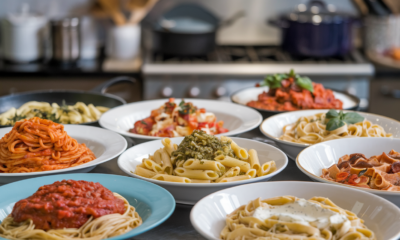
 Pasta Recipes10 months ago
Pasta Recipes10 months ago10 Easy Pasta Recipes for Busy Weeknights
-

 Pasta Recipes9 months ago
Pasta Recipes9 months agoSacchetti Pasta Recipe: Little Pouches of Flavor to Impress
-
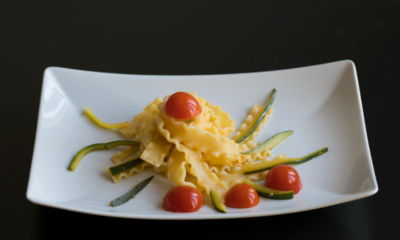
 Pasta Recipes9 months ago
Pasta Recipes9 months agoTry This Delicious Mafaldine Pasta Recipe for a Perfect Italian Dish






